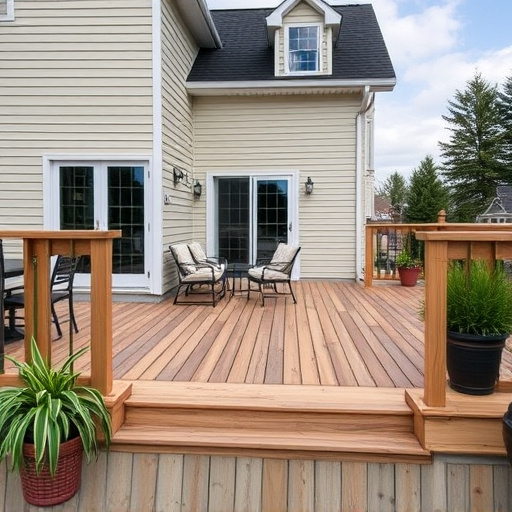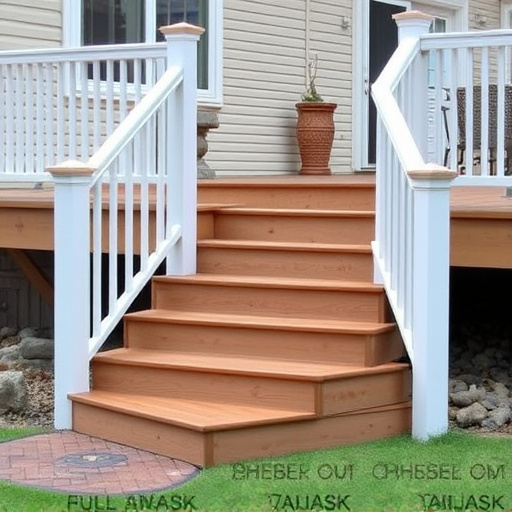Revolutionize Residential Decking: Safe, Slip-Resistant Surface Options
Residential decking transforms outdoor spaces into functional living areas, boosting property value…….
Welcome to an extensive exploration of residential decking, a versatile and popular feature that transforms outdoor areas into vibrant extensions of modern homes. This article aims to guide readers through the intricacies of decking, from its fundamental components to global trends, economic implications, technological innovations, regulatory considerations, and future prospects. By delving into these aspects, we will uncover the significance of residential decking in enhancing urban landscapes and improving the quality of life for residents worldwide.
Residential decking refers to outdoor structures built to extend living spaces, typically attached or adjacent to a residence. It involves creating a raised platform using materials like wood, composite materials, or stone, offering a versatile area for various purposes, from casual gatherings to entertainment. The core components include:
The concept of residential decking has deep roots in human history. Early decks were simple structures used by maritime cultures for sailing vessels and coastal homes, offering a connection to the sea. Over time, as construction techniques evolved, so did decking, becoming a prominent feature in residential architecture. In modern times, with an increasing focus on outdoor living and entertainment, decking has become a versatile design element worldwide.
Residential decking serves multiple purposes:
Residential decking has spread globally, adapting to diverse climates and cultural preferences. Its influence is evident across continents:
The global residential decking market is a significant sector within the construction industry, with various factors influencing its growth:
| Factors | Impact |
|---|---|
| Real Estate Trends: High demand for outdoor living spaces drives decking market growth, especially in regions with mild climates. | 🌡️ |
| Homeowner Preferences: Increasing desire for customizable, low-maintenance outdoor areas boosts sales. | 🔧 |
| Technological Advancements: Innovation in materials and design leads to more efficient and aesthetically pleasing decks. | 💡 |
| Urbanization: Growing cities create a need for vertical and rooftop decking solutions. | 🏢 |
Decks are often considered valuable investments, offering both functional and financial benefits:
Residential decking is integral to local economies:
Technological advancements offer:
Governments worldwide have implemented various policies and regulations to ensure safe and sustainable decking practices:
These policies have led to:
Despite its popularity, residential decking faces several challenges:
Location: Downtown Toronto, Canada
Design: A multi-level decking project transformed a rooftop into a vibrant urban oasis featuring a living roof, integrated solar panels, and customizable lighting.
Lessons Learned: This case highlights the potential of vertical decking in urban settings, offering residents a peaceful retreat while minimizing impact on limited land resources. Customization and sustainable elements are key to successful design.
Location: Sydney, Australia
Design: A waterfront property was enhanced with a large composite deck, complete with built-in seating, sun lounges, and a custom-designed pergola for outdoor dining.
Impact: The project successfully blended indoor and outdoor living, capitalizing on the stunning coastal views. The use of eco-friendly composites demonstrates a harmonious balance between modern design and environmental considerations.
Location: Berlin, Germany
Design: A contemporary deck featuring ipe wood flooring, integrated water walls, and LED lighting creates a tranquil outdoor space.
Achievements: This project showcases the beauty of natural materials combined with modern design elements. The water features enhance the sensory experience, offering residents a unique outdoor retreat.
Residential decking has evolved from a simple outdoor structure to a sophisticated means of enhancing urban landscapes and improving the quality of life. Its global impact, economic significance, and technological advancements underscore its importance in modern architecture. As we look ahead, the industry’s future prospects are promising, with sustainable materials, smart technology, and innovative designs taking center stage.
By addressing challenges, embracing new trends, and adhering to regulatory frameworks, residential decking can continue to flourish while contributing to more livable and environmentally conscious communities worldwide. This article has provided a comprehensive overview, but the journey of exploration is ongoing, as the industry continues to evolve with changing preferences, technologies, and environmental considerations.
Q: How much does a typical residential decking project cost?
A: Costs vary widely based on deck size, materials used, location, and complexity of design. On average, it can range from $25 to $75 per square foot, with larger projects or custom designs potentially exceeding $100 per square foot.
Q: What is the best material for a deck?
A: The ‘best’ material depends on individual preferences and priorities. Wood offers natural aesthetics but requires maintenance, while composite materials are low-maintenance and eco-friendly. Stone decks are durable but more expensive. Each option has its advantages, so consider your needs and budget.
Q: How do I ensure my deck’s safety?
A: Regular inspection is crucial. Check for loose boards, secure railings, and proper footings. Use non-slip decking materials in wet areas. Ensure proper installation and maintain a clear fall prevention distance from edges. Regular maintenance can prevent accidents and structural issues.
Q: Can I build a deck myself?
A: DIY decks are possible for simple, smaller projects. However, complex designs or larger structures often require professional skills and knowledge. Consult local building codes and consider seeking expert advice for intricate builds to ensure safety and compliance.
Q: How can I make my deck more energy-efficient?
A: Incorporate energy-efficient features like LED lighting, solar panels, and insulated decking materials. Consider smart home technology that adapts lighting and temperature to user preferences and environmental conditions. These measures contribute to a more sustainable outdoor living space.

Residential decking transforms outdoor spaces into functional living areas, boosting property value…….

In recent years, residential decking has evolved from simple structures to key components in enhanci…….